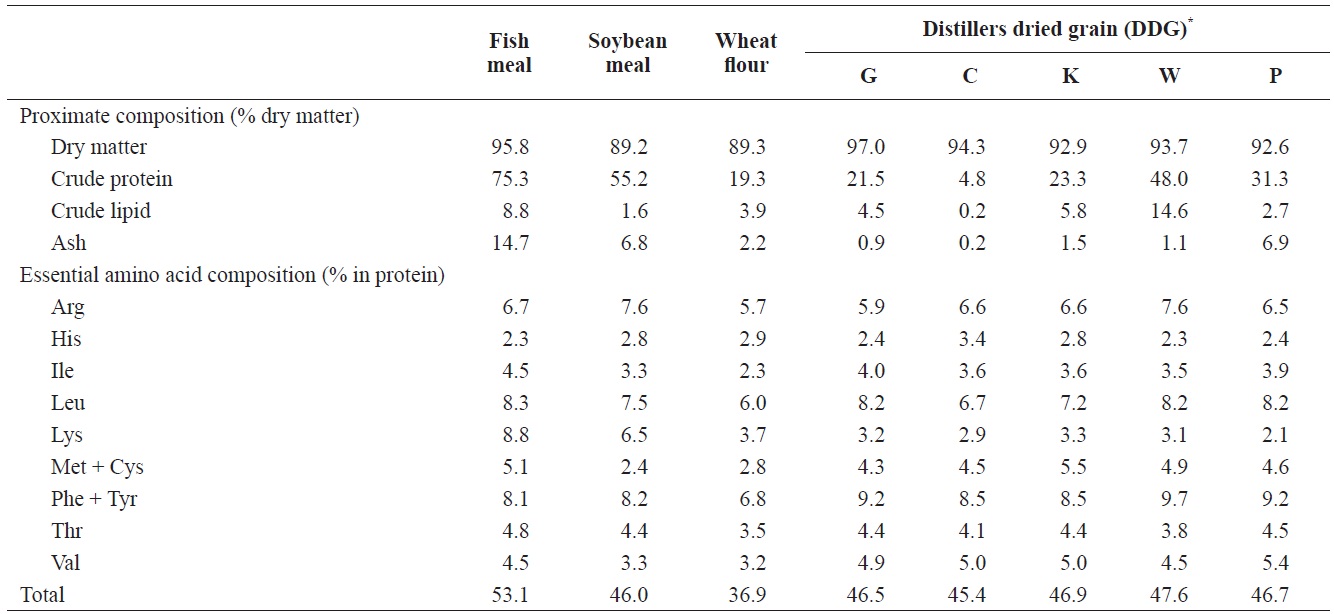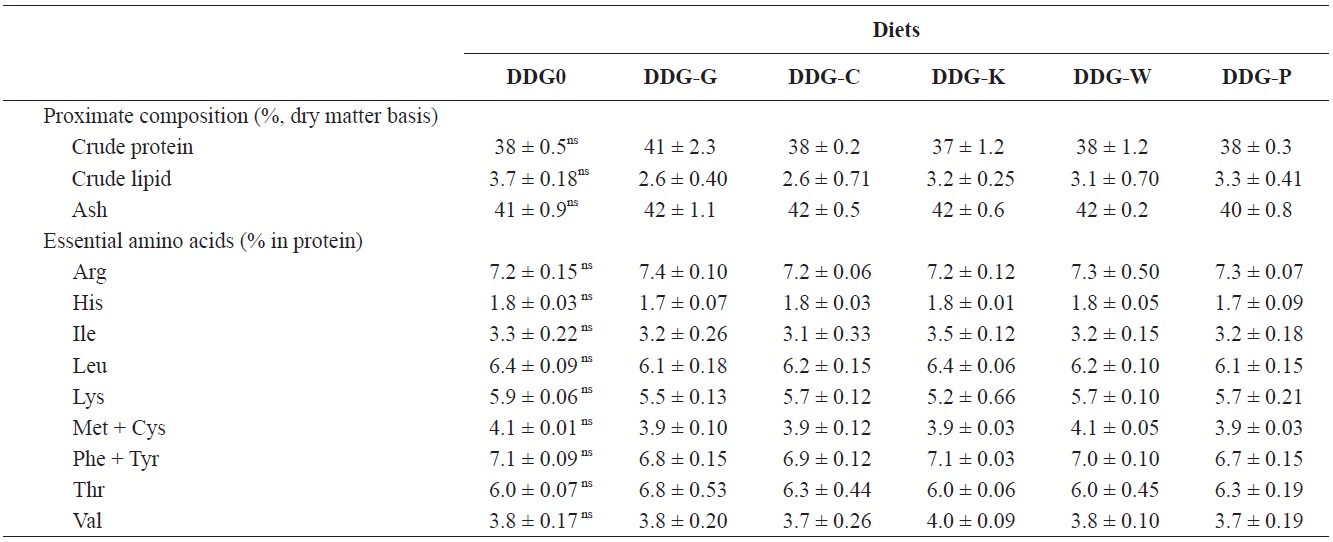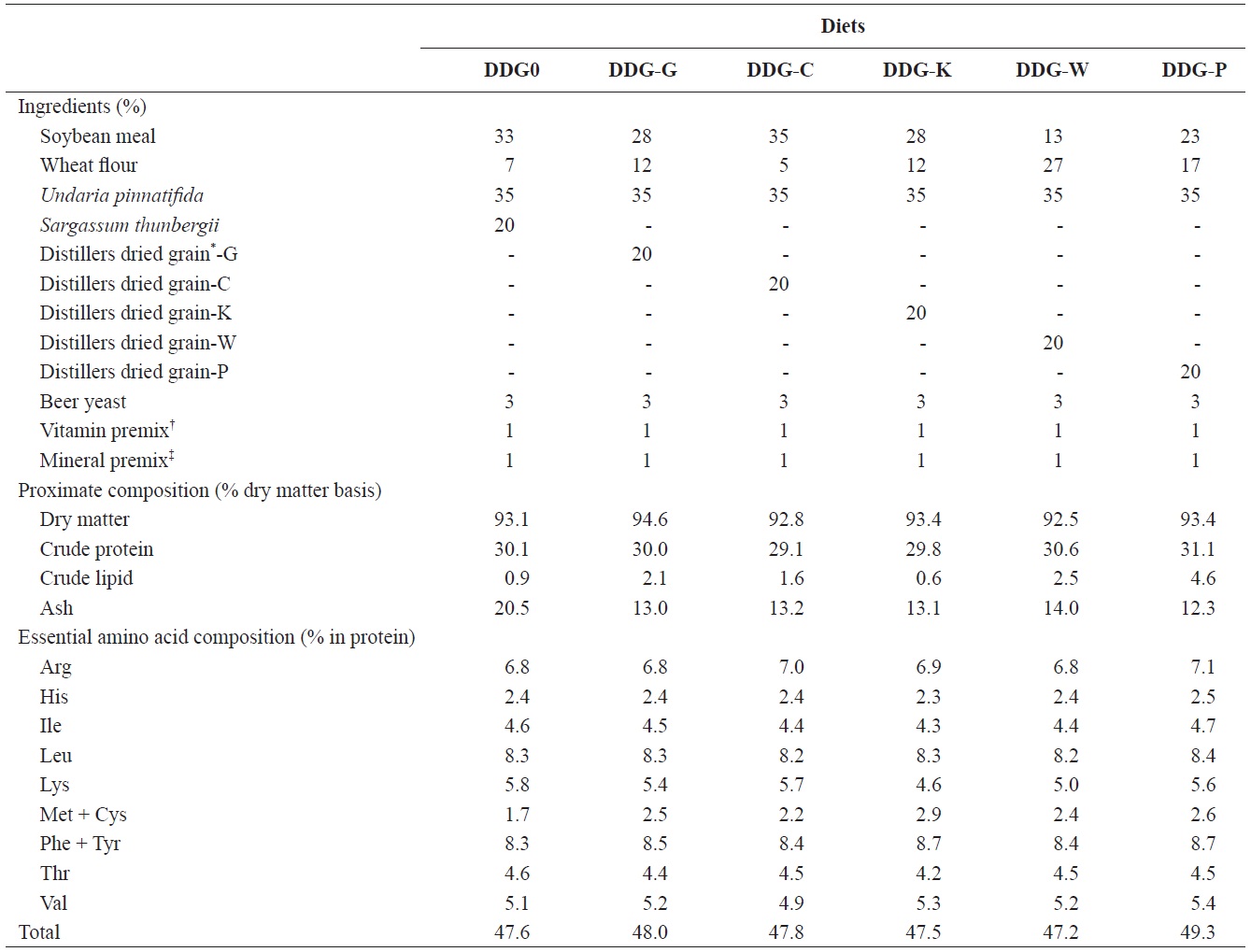



The sea cucumber
Many studies have reported the nutrient requirements (Choi et al., 2009; Seo et al., 2011a, 2011b) and feed ingredients (Yuan et al., 2006; Liu et al., 2009; Slater et al., 2009) for growth of sea cucumber. Seo and Lee (2011) found that sea cucumber require relatively low dietary protein and lipid content for optimum growth. Based on the previous finding, we hypothesized that incorporating a vegetable ingredient such as distillers dried grain (DDG) into the diet might reduce feed costs (Seo et al., 2011a; Rahman et al., 2013). DDG is a cereal by-product of distillation processing and has great potential for use as an aquatic animal feed ingredient (Lim et al., 2007, 2009). Therefore, we conducted this study to investigate the effects of DDG as a promising dietary ingredient on the growth and body composition of juvenile sea cucumber.
The essential amino acid and proximate compositions of ingredients used in the experimental diets are presented in Table 1. Ingredients and nutrient contents of the experimental diets are presented in Table 2. Soybean meal and algae
>
Experimental animal and feeding experiment
Juvenile sea cucumber were obtained from a local sea cucumber farm (Taean, Korea), and acclimated to the experimental condition for 2 weeks. Juvenile sea cucumber (average body weight, 2.1 ± 0.02 g) were randomly allocated to eighteen 50-L rectangular plastic tanks (40 L of water each) in a seawater flow-through system at a density of 50 animals/tank. Three replicate groups of sea cucumber were fed one of the six experimental diets at a feeding rate of 5% body weight per day

Proximate composition and essential amino acid (% in protein) of the ingredient of experimental diets
every other day (17:00 h) for 22 weeks. Filtered seawater was continuously supplied at a flow rate of 1 L/min. Water temperature was maintained at 10.7 ± 1.07℃, and the photoperiod during the feeding trial followed natural conditions. Each tank was cleaned by siphoning every 2 days.
>
Sample collection and chemical methods
All sea cucumber surviving at the end of the feeding experiment were collectively weighed and sampled after 24 h of starvation, freeze dried, and ground with a mortar and pestle. Proximate composition of the experimental diets and whole body of the sea cucumber were analyzed according to standard methods (Association of Official Analytical Chemists, 1995). Crude protein content was determined by the Kjeldahl method using an Auto Kjeldahl System (Buchi, Flawil, Switzerland). Moisture content was measured after drying in a 105℃ oven for 6 h. Crude lipid was determined by the ether-extraction method, and ash content was determined with a muffle furnace at 600℃ for 4 h. Amino acid composition in the experimental diets and whole body of sea cucumber were analyzed using an automatic amino acid analyzer (L-8800; column, ion exchange; injection pump pressure, 0-19.6 Mpa; flow rate, 0.05-0.99 mL/min; column oven, electrothermal cooling [30-70℃]; reaction unit, reaction column [135℃ and 50℃]; photometer: wavelengths 570 and 440 nm; Hitachi, Tokyo, Japan).
Data were subjected to one-way analysis of variance using SPSS version 18.0 (SPSS, Inc., Chicago, IL, USA). Significant differences (
The growth performance of juvenile sea cucumber fed the experimental diets containing dietary DDG are presented in Table 3. Survival and weight gain of juvenile sea cucumber were not affected by dietary DDG (
[Table 2.] Ingredient and composition of the experimental diets

Ingredient and composition of the experimental diets
the whole body in juvenile sea cucumber were not affected by dietary DDG (
No differences in growth and body composition of sea cucumber in this study by dietary DDG indicate that the rice-based DDG used in this study is considered to be a candidate as a feed ingredient for juvenile sea cucumber. Many authors have found satisfactory growth performance in tilapia when fed a diet containing corn-based DDG (Wu et al., 1996, 1997; Coyle et al., 2004; Schaeffer et al., 2009). Robinson and Li (2008) demonstrated that up to 30% corn-based DDG can be integrated into the channel catfish diet without negative effects on growth performance. Furthermore, dietary corn-based DDG may improve palatability in sunshine bass (Thompson et al., 2008). In the present study, weight gain in sea cucumber

Growth performance of juvenile sea cucumber (initial average body weight, 2.1 ± 0.02 g) fed the experimental diets for 22 weeks*

Proximate (%) and essential amino acid composition of the whole body in juvenile sea cucumber fed the experimental diets for 22 weeks*
fed diets containing DDG was not different from that of the control group. This is thought to be due to the improved digestibility and removal of anti-nutritional factors in the DDG by fermentation. Fermentation of legumes is an important process that can develop nutritive value and reduce specific anti-nutritional factors such as phytic acids, protease inhibitors, and flatulence factors (Yigzaw et al., 2001). Including fermented soybean meal using
The results of our study suggest that rice-based DDG is a good dietary ingredient and could be used at concentrations up to 20% in diet for growth of juvenile sea cucumber.





